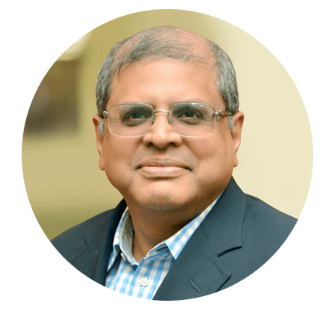In the corporate world, any talk of building a high-quality business is immediately followed by the act of building organisational capability. It is almost intuitive to think of putting the building blocks in place: organisation charts, the right people for those organisation charts, and systems and processes. In fact, boards and funders that back the business focus enormously on these aspects in the early days of the organisation’s journey before they start expecting results.
In the social sector,however, the conversation almost always starts with the results—the entire emphasis is on the plan and the programme as opposed to whether the organisation is geared to delivering in a high-quality and a sustainable way. Thus, the model is, in a sense, inverted in the nonprofit space.
And we find this extremely unusual because, very often, philanthropists (who are business people themselves) are unable to translate this corporate sector thinking to the nonprofit space.

Why organisational capacity is not a priority for nonprofits
Financial sustainability is not something that a nonprofit can usually think of from day one. Most nonprofits are set up by passionate leaders who start a programme and focus all their energies on building it, mainly because resources are usually scarce early on.
What they need are donors who are willing to support them for at least three years. Else, the focus shifts to assessing the programme’s achievements every year, after which the donor may or may not decide to renew the relationship. This puts unnecessary pressure on the programme, with the result that organisation building is always relegated to the sidelines.
It also doesn’t help that donors typically tell nonprofits: “I want to fund only programme costs; every rupee I give must go towards feeding or educating or clothing somebody.” And their next question usually tends to be: “What is your administrative cost? ”If it’s high, then you are not seen as ‘efficient’.
Related article: Do you have the patience to create impact?
Given that they are invariably answering such questions, nonprofits don’t really want to think about investing in building an organisation. The inflection point happens when the founder or CEO feels confident of the impact they are making and starts saying: “Let me build infrastructure around my programme, whether it is to raise funds, talk about my programme or for financial stability.”

Scale cannot be achieved overnight
Most funders would like their nonprofits to scale as fast as possible and most donor conversations invariably land at this point.
We’ve had these conversations at Jai Vakeel as well. “It’s great that you have 700 students in one campus; but given the population of India, what are your plans for scale? We would like to support your growth if we can see that pathway to scale.” And our honest response was to tell them that we weren’t ready.
We understand this is a country with so many people and we need to address the problem for them, but Jai Vakeel is not able to do it today because we don’t have the kind of infrastructure, people and skills required to do it on a larger scale.
Besides, one can’t go from a start-up stage to scale-up stage; there has to consolidation in the middle. And capacity building is what ensures that that happens.
Funders like to say: “This is a great pilot; you have proved it for a thousand people, now let’s take it to hundreds of thousands.” As business people they would never go to even the thousand-and-first person without building their own in-house capability to make it happen. For some reason, though, they can’t or won’t apply that same logic to nonprofits.
Related article: Want sector-level change? Go beyond funding just programmes.
We have raised the bar and our expectations from the social sector: we expect miraculous results without equipping the sector and putting in adequate inputs. And that’s really unfair. Which is why this investment in leaders and capacity building is very important.
Most leaders are passionate and driven people but may not necessarily have the entire gamut of business skills. What are we as funders doing to equip these leaders to deal with the whole scaling model that we are so aggressively pushing on them?
For nonprofits, too, it can be tempting to jump to scale without stopping to build internal capabilities and processes. It’s easy to get lured by this kind of money and play the numbers game, but that can be counter-productive in the long term.

It is unfair to expect miraculous results from the social sector without investing adequately in leadership and capacity building. (Image courtesy: Aseema Charitable Trust)
Making the case for investing
Given this state of affairs, our sector as a whole must talk more about success stories:
- Organisations that have broken out because they have made an extraordinary investment in capacity building should be talked about and celebrated by stakeholders and the development community.
- Donors who have invested in capacity building and have seen great results in the organisations they have backed should talk about their experiences for the benefit of their peers, who can then consider making similar investments.
Nonprofits should be bolder when they approach donors and make the case for achieving results via investments in organisational capabilities.
Akshaya Patra is a good example of this. We read Rashmi Bansal’s God’s Own Kitchen,* which narrates the story of the organisation, and the biggest lesson for us in that was about investing in organisational capacity early on.
When you read the book, you realise that its early supporters—people like Mohandas Pai, who had experience building world-class organisations in their corporate avatars—saw the opportunity to take Akshaya Patra to the next level by investing in what really mattered: technology, systems, processes, governance, etc. It probably explains why Akshaya Patra operates at the scale at which it does today.
We’ve had the same experience in a much smaller way across the 25 organisations that we support in our capacity building portfolio. Our learning: it very important to make targeted investments in organisations in different functional areas to unlock their full potential.
Just as successful businesses are the product of extensive nurturing and investment in people, processes and the like, we in the social sector must also start asking ourselves if we are doing enough in our various roles—as funders, philanthropists, nonprofit founders, and so on—to take cognisance of the fact that there are no short-cuts on this journey.
* A.T.E Philanthropic Foundation, which anchors Amit and Archana Chandra’s philanthropic initiatives, is offering a complimentary copy of this book to nonprofit leaders. Please fill out this form by GuideStar India to request your copy. The offer is open to the first 1,000 nonprofits who apply by March 16, 2018 .
The artwork above is courtesy of the nonprofit Aseema. For more information, please click here.
Disclaimer: IDR is funded by ATE Chandra Foundation.





